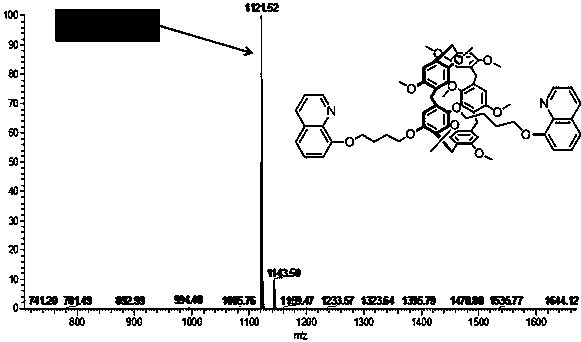Supermolecular sensor based on host-guest self-assembly and preparation and application thereof
A technology of host-guest self-assembly and guest molecules, applied in the field of ion detection, can solve the problems of few reports
- Summary
- Abstract
- Description
- Claims
- Application Information
AI Technical Summary
Problems solved by technology
Method used
Image
Examples
Embodiment 1
[0049] Example 1. Synthesis of supramolecular sensor PQDP-Ag
[0050] 1. Synthesis of main molecule PQ
[0051] (1) Synthesis of two-sided four-carbon pillar [5] arene P5C4: by literature method: T. B. Wei, J. F. Chen, X.B. Cheng, H. Li, B. B. Han, Y. M. Zhang, H. Yao and Q. Lin. Org. Chem. Front., 2017, 4, 210.
[0052] (2) Synthesis of 8-hydroxyquinoline functionalized column[5]arene PQ: add 1mmol (0.9923g) of two-sided carbon column[5]arene P5C4 and 0.5mmol (0.0829g) of potassium iodide to a 100mL round bottom flask and 60mL of acetonitrile, stirred at room temperature for 30 minutes, added anhydrous potassium carbonate 10mmol (1.3791g) and 8-hydroxyquinoline 2.5mmol (0.3626g), immediately with N 2 protection, the mixture was heated to reflux at 90°C for 72 hours, mixed with silica gel, spin-dried, and purified by column chromatography (petroleum ether:ethyl acetate=5:1v / v), and the obtained pale yellow product was PQ. Yield: 50.8%, melting point: 97~103°C.
[0053] 2. ...
Embodiment 2
[0057] Example 2: Supramolecular Sensor PQDP Fluorescence Recognition of Ag +
[0058] Take 13 10mL colorimetric tubes, respectively pipette 0.5mL DMSO solution with the above PQDP into the 13 colorimetric tubes, 1.0 mLH 2 O, and then add 13 kinds of common cationic Ag respectively + , Zn 2+ , Fe 3+ , Hg 2+ , Ni 2+ , Ca 2+ , Cu 2+ ,Co 2+ , Cd 2+ , Pb 2+ , Cr 3+ , Mg 2+ and Al 3+ DMSO solution (0.02mol L -1 ) 0.5mL, and finally dilute to 5.0mL with DMSO, shake to mix evenly, and detect the fluorescence response of PQDP to cations with a fluorescence spectrophotometer. If the fluorescence of the sensor PQDP is significantly enhanced, it means that the addition of Ag +. If the fluorescence of the sensor PQDP does not change significantly, it means that other ions are added.
Embodiment 3
[0059] Embodiment three, supramolecular sensor complex PQDP-Ag fluorescence recognition I -
[0060] Take 13 10mL colorimetric tubes, and pipette 0.5mL of the DMSO solution of PQDP into the 13 colorimetric tubes respectively. 2 O 1.mL, Ag + DMSO solution (0.02mol L -1 ) 0.5mL; then add F - , Cl - , Br - , I - , AcO - , H 2 PO 4 - , HSO 4 - , ClO 4 - , SCN - and CN - solution (0.1mol L -1 ) 0.5mL, and finally dilute to 5.0mL with DMSO, shake to mix evenly, and detect the fluorescence response of PQDP-Ag to anions with a fluorescence spectrophotometer. If the fluorescence of the sensor complex PQDP-Ag is red-shifted and enhanced, it means that the addition of I - .
PUM
 Login to View More
Login to View More Abstract
Description
Claims
Application Information
 Login to View More
Login to View More - R&D
- Intellectual Property
- Life Sciences
- Materials
- Tech Scout
- Unparalleled Data Quality
- Higher Quality Content
- 60% Fewer Hallucinations
Browse by: Latest US Patents, China's latest patents, Technical Efficacy Thesaurus, Application Domain, Technology Topic, Popular Technical Reports.
© 2025 PatSnap. All rights reserved.Legal|Privacy policy|Modern Slavery Act Transparency Statement|Sitemap|About US| Contact US: help@patsnap.com



